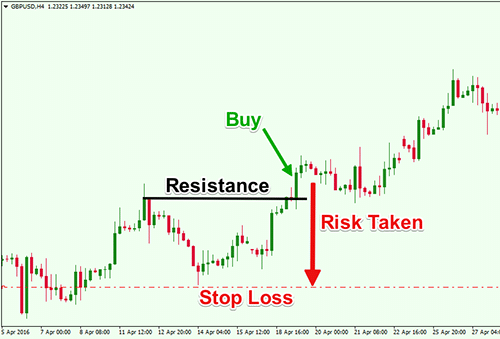Stop-Loss Hunting: How Crypto Whales are Making a Killing
If there is one thing that any trader will know it is the outsized impact that cryptocurrency whales have on the markets. They are able to use their out sized positions to drive the prices in the directions they want.
Now it seems as if these whales are out hunting your stops and buying up all of your cheap coins.
Stop hunting has been around in the Foreign Exchange market for a number of years. It is often quite an effective way for large institutions such as Hedge Funds and Investment Banks to flush out smaller traders who have leveraged positions with weak longs / shorts.
However, in the cryptocurrency markets where many Altcoins operate with not that much liquidity, stop-loss hunting can be much more effective. Moreover, whales can be any individual with a respectable BTC holding and an eye for a good coin.
Let's take a look at this powerful weapon that is being used with deadly effect.
Quick Overview of Stop-Losses

Stop-losses are automatic orders to sell a cryptocurrency when it falls to a certain level. They are placed on a trading platform and can be left open for a day (daily order) or forever (good till cleared). As one can tell, they are used in order to stop losses at important levels.
The positions are chosen around important psychological levels. These levels are usually those that end on a round number. People find it easier to compartmentalise their gains / losses from round numbers. Hence, at any psychological level there are likely to be a large number of stops just below them.
When it comes to hunting stops in the Forex markets, the large institutions know that there are many traders who are highly levered and will have stops above and below current levels. They will take advantage of these highly levered traders with weak positions.
In smaller altcoin markets, there is not likely to be high leverage nor traders with short stops. However, the low liquidity in some of these markets is no doubt an advantage. At particular times of the day, a trader with Bitcoin positions of between $500k-$1m is likely to have a massive impact with their orders.
For example, it is entirely possible for one trader who holds a large volume of an Altcoin to drive the price down by over 10% in a mere matter of minutes. This is where they make the most money.
How Does Stop-Loss Hunting Work?

Crypto whales will hold large positions in an Altcoin that they think is great value and is likely to rally soon on impending news. They want to increase their stake in the coin substantially. However, the amount they would like to invest is no doubt likely to drive the price up.
Hence, they use their large long positions to their advantage. They need to go "hunting" for some easy liquidity on the sell side.
These Crypto whales know for a fact that there are likely to be great deal of stop-loss orders around important levels below the current price. They count on the fact that traders are naturally risk averse and will leave these orders as "good till cleared".
Hence, they will send through a great deal of sell orders on the current positions that they hold. They will also stagger these large positions at lower levels in order to create a large "sell wall". These sell walls are hard for smaller traders to break through.
Moreover, given the nature of crowds and the "weak hands" of many who have just entered the cryptocurrency markets, a panic may ensue. Traders may be induced to manually sell as they worry about their holdings falling even more. These ads to the large sell wall created by the whale.
This could drive the price down a great deal to a point where it even goes below the important pshycologival levels. Below these levels, the whale knows lies the lucrative stops. Once the price has moved to a level that he deems attractive, he will place start buying up the coins that the stops are offering.
As the price keeps moving lower, these stops will keep getting triggered and the whale will average his purchases down. The whale will keep on buying until he has recouped what he has already sold plus a larger stake.
By now, the other market participants including other whales are aware of the lower coin prices and start coming in. The price of the coin now rallies and recovers the lost ground. Those who had their stops met are stuck with less coins and the whale is sitting pretty with a larger portfolio that is likely to rally when more important news breaks.
Let us take a look at a simple stop-hunting example with a hypothetical Altcoin, Minnow (MNN).
Example of Stop-Loss Hunting
There is a whale that currently holds a great deal of MNN (30 BTC worth) and he also has a great deal of BTC lying in his wallets ready to use. This whale is of the view that there is likely to be some news from MNN that will make the price pump in the next few days. Currently, MNN is trading at 10,500 Satoshis (0.000105 BTC).
The whale wants to increase his position in MNN to 50 BTC worth. However, currently the order book is rather small. There are currently only 5 BTC of buy orders for the coin between the current price and 0.00105 BTC. Hence, he cannot place a buy order of 20BTC as it will drive the price up.
This whale needs to find himself a great deal of sell orders at attractive levels. Given his intuition, he knows that these sell orders are sitting just below key levels. In this case, he assumes that these levels are just below 10,000 and down to 9,500.
Now the whale is ready to begin his hunting expedition. He will follow the below steps.
- The whale will place market sell orders at the current price of 10,500 for 4 BTC. This is likely to drive the price down to 10,100.
- The whale will place a number of other orders at 10,500 for 4BTC that makes a large "sell wall" appear. The hope of the whale is that this will make the smaller traders panic and start selling as well.
- The whale will keep placing orders hoping that the price will now fall to 10,000. Hopefully panic may become more acute. He will keep doing this until the price falls to 9,900. He will have sold off an additional 2BTC.
- At this stage, the whale has sold off 10 BTC worth of MNN. Yet, the price has been driven below the psychological level of 9,900. This means that many of the stop-losses that had been just below this level will get triggered. They are limit orders which means that they will be sold at the market price. These are all automatically placed and will keep driving the price down.
- The price has now fallen to 9500 and you have had a fall of over 10% in a mere matter of minutes purely by your actions. There is also a mass of liquidity that has been created by all of the stop-loss orders. In this case, there are 30 BTC worth of MNN sell orders on the books at prices ranging from 9,500 to 10,500.
- The whale completes his work and matches these sell orders at all of these levels. He scoops up the remaining 30 BTC at a 10% discount to what it was before.
- The result of this hunting expedition is that the whale now has an additional 20BTC that he picked up at bargain prices at the expense of the smaller traders. The whale will now wait for the pump he has been looking for
The whale could also combine this exercise with social media FUD if he wanted. He could use other traders and influencers with large followings to spread negative news about MNN that could help precipitate the sale and give him even cheaper coins.
They could also then do this on the upside as they try to drive the price up with positive sentiment and rumours on social media. Below is an example of a typical stop-loss hunting expedition in a chart.

Example of Stop Loss Hunting on Charts
As you can see the price is falling on rather low volume that starts to pick up larger volume as the stop-loss orders are placed. Eventually, when the price is at a level the whale deems appropriate he will place a whole host of buy orders. This is where the price rallies on large volume afterwards. The price recovers and the whale has more coins.
This process can be completed in a mere matter of minutes and can also be combined with trading algorithms on the exchanges. Hence, you may be surprised to log out of your account, log back in and see that your stops have been executed even though the price appears the same. That is because the stop-hunting happened even before you even noticed it.
How to Stop Falling Victim
No one wants to risk giving their coins up to the whales for bargain prices. There are a few things that you can do in order to avoid having your coins snatched. An attractive alternative to stop-losses could be price alerts. These will let you know via a text or email that the price has reached a certain level.
If it has indeed reached that level then you can log in and assess the situation. It will allow you to think more in depth about whether the situation is a genuine sell off or whether a whale is stop-hunting.
If, however, you are still not comfortable without a stop loss in place then you just have to place them more strategically. Don't place them at all of the obvious pshychological levels. In the case above, it was clear that 10,000 was a key level. You should either place them well above this level or somewhere below.
This will mean that your stops will either get cleared at a price that is closer to the initial or they will avoid being tripped because they are considerably below the 10,000 level.
Keep Calm and HODL
The type of cryptocurrency investors who are not likely to get hurt by this scheme are those that choose to HODL. They will hold onto their coins without any stops in place and will not be swayed by price swings.
Those hodlers have a view of the long term value of the coins and do not fixate on price points. They are not traders and will never have stop-losses in place for the whales to take advantage of.
Hodling is of course not for everyone and some traders would not feel comfortable leaving positions open without any sort of oversight. In this case smart stops and price alerts will go a long way in surviving hunting season.
Disclaimer: These are the writer’s opinions and should not be considered investment advice. Readers should do their own research.
